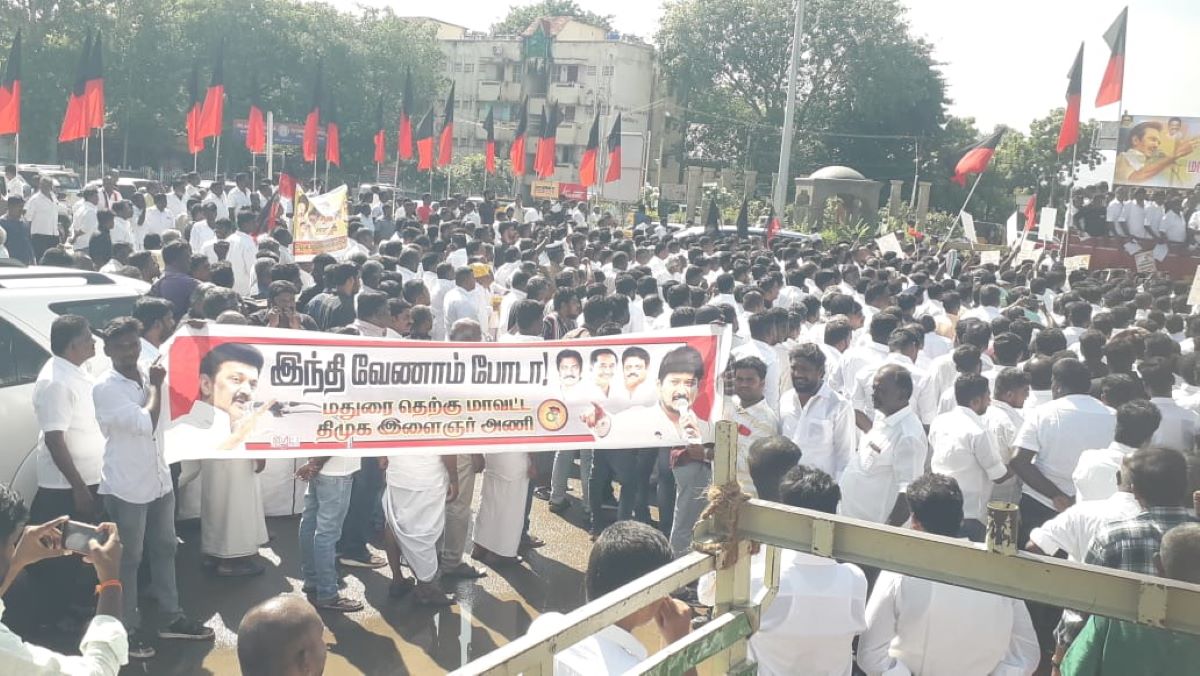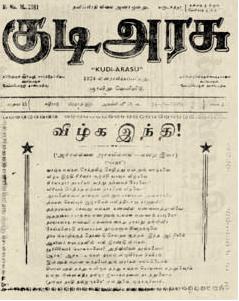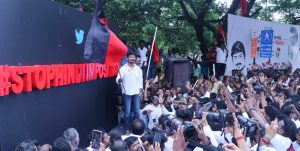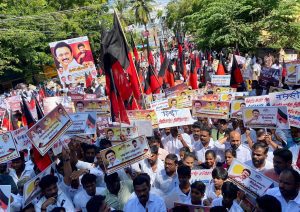The anti-Hindi sentiment in the state might be old but is not obsolete. Not as long as the imposition of Hindi remains a potential threat to the idea and identity of Tamil Nadu.

Anti-Hindi protest in Madurai by the DMK youth wing on 15 October (Twitter/DMKYouthWing)
Three days before the agitation of the DMK youth wing and students wing against alleged Hindi imposition by the BJP-led Union government, the Twitter handle @IndiaHistorypic tweeted a very telling image from the anti-Hindi imposition agitations of the 1960s in Tamil Nadu.
The image had a group of women holding placards that said ‘Thamizh Vaazhga’ (Long Live Tamil) and raised questions such as ‘Hindi or India?’ The picture perhaps demonstrated the sentiment against the imposition of Hindi in the state — a sentiment now part of the character that defines Tamil Nadu.
The first agitation against the imposition of Hindi took place in the late 1930s after C Rajagopalachari, the then chief minister of the Madras Presidency, made Hindi mandatory in secondary schools.
Periyar led the protests, which saw a large turnout of women. Notable among them were Dravidian luminaries such as Moovalur Ramamirutham Ammaiyar, S Dharmambal, and Meenambal Sivaraj, who along with others braved it out through court proceedings and emphatically declared that they fought for their language, for their rights, and “for the future generations”.

An editorial in 1939 in ‘Kudiyarasu’ run by Periyar. The headline reads ‘Down with Hindi’ (Wikimedia Commons)
While there were sporadic anti-Hindi protests since then, the second major anti-Hindi agitation happened in the 1960s when the then Prime Minister Jawaharlal Nehru in 1963 sought to make Hindi the sole official language, replacing English by 1965.
Women did participate in these agitations, but these were primarily led by the students. An umbrella organisation of students was formed, several student conferences were held, and some agitators died by suicide in protest. The move was finally withdrawn following Nehru’s assurance about English remaining one of the official languages as long as non-Hindi speaking people want it.
That the sentiment remained strong even after decades of these agitations was proved yet again when DMK MP Kanimozhi in August 2020 took to Twitter to express her resentment over a CISF personnel asking her if she was an Indian when she said that she did not know Hindi.
Today at the airport a CISF officer asked me if “I am an Indian” when I asked her to speak to me in tamil or English as I did not know Hindi. I would like to know from when being indian is equal to knowing Hindi.#hindiimposition
— Kanimozhi (கனிமொழி) (@KanimozhiDMK) August 9, 2020
It perhaps resonated with the question that the placard held aloft by a woman from the 1960s anti-Hindi protests had – Hindi or India?
What followed Kanimozhi’s tweet was nothing short of a social media phenomenon. Celebrities took to social media to speak against Hindi imposition and asserted their linguistic pride; youth after youth shared photographs wearing T-shirts that had anti-Hindi slogans. There were some celebrities too who joined the trend and posted photographs with the T-shirts.
Deep in discussion , good things coming our way … ! ???? @thisisysr pic.twitter.com/VSgaNQQNvw
— ????? ??????? (@actor_shirish) September 5, 2020
The phenomenon made one thing clear. Opposition to Hindi was evidently not forgotten. As long as there were attempts towards the imposition of Hindi in states such as Tamil Nadu — which doesn’t just take fierce pride in its language but has done better in a number of aspects than the many Hindi-speaking states — there would be opposition.
It meant that any slight attempt to impose Hindi even at an individual level could evoke a wave of passionate responses by way of wearing T-shirts and posting images on social media. Or a simple question posed to a panelist by an anchor of a Tamil television channel about Hindi literature could go viral.

DMK youth wing protest led by Udhayanidhi Stalin in Chennai against Hindi imposition on 15 October (Supplied)
This time, it is not at an individual level though. The recent spate of protests against Hindi imposition — both online and offline — comes after the recommendation of the Parliamentary Committee of Official Languages headed by Union Home Minister Amit Shah suggesting that Hindi be made mandatory in technical and non-technical institutions including Central Universities — an idea antithetical to the very character of Tamil Nadu.
Besides a letter to Prime Minister Narendra Modi where Chief Minister MK Stalin called the attempt “impractical and divisive in character” putting non-Hindi speaking people in a disadvantageous position, the DMK also swung into action and had its youth wing and students wing organise a massive protest against the move.
On the same day, the DMK trended #StopHindiImposition on social media. If there is to be a repeat of 1965-style agitations as a section of DMK leaders warn given the persistence of the Union government in its idea of making Hindi mandatory in educational institutions, there perhaps couldn’t be a better way than having the protests led by the students and youth — the section that had spearheaded the protests in 1965.

Anti-Hindi protest in Dharmapuri, Tamil Nadu, by the DMK youth wing on 15 October (Twitter/DMKYouthWing)
And there is the participation of women too, who have demonstrated extraordinary courage in opposing the imposition of Hindi both during the first and second agitations. DMK youth wing leader Udhayanidhi Stalin warned of protests in Delhi in the face of any attempt by the Union government to impose Hindi. But more importantly, he spoke about how the anti-Hindi agitation could be a “great start for the Lok Sabha poll campaign”.
With Lok Sabha elections scheduled for 2024, there really couldn’t be a better start for the DMK. After all, the 1965 anti-Hindi agitations, along with many other factors, led to the ousting of the Congress from power in 1967 and the formation of the first DMK government. The Congress has not been able to return to power since.
Opposition to the imposition of Hindi could well be a rallying point for many parties and movements against the BJP, which is working hard to gain ground in Tamil Nadu — a state that has remained a tough nut for it to crack.
The anti-Hindi sentiment in the state is too deep to be ignored, too strong to be broken. It might be old but is not obsolete. Not as long as the imposition of Hindi remains a potential threat to the idea and identity of Tamil Nadu.
(Kavitha Muralidharan is an independent journalist based out of Chennai with over two decades of experience covering Tamil Nadu through the lens of politics, films, culture, human rights and women’s issues. These are the personal views of the author)

Dec 14, 2023

Oct 24, 2023

Sep 14, 2023

Aug 26, 2023

Jun 13, 2023